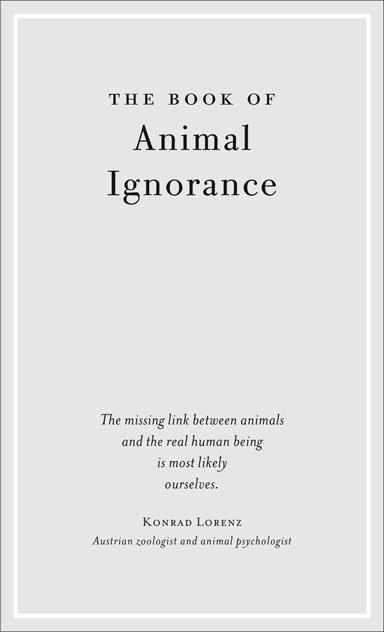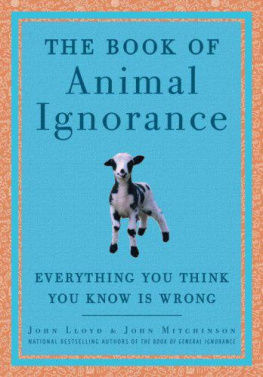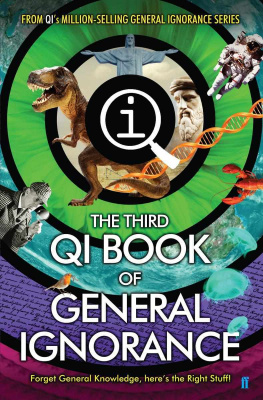John Lloyd - The Book of Animal Ignorance: Everything You Think You Know Is Wrong
Here you can read online John Lloyd - The Book of Animal Ignorance: Everything You Think You Know Is Wrong full text of the book (entire story) in english for free. Download pdf and epub, get meaning, cover and reviews about this ebook. year: 2007, publisher: Random House, Inc., genre: Science. Description of the work, (preface) as well as reviews are available. Best literature library LitArk.com created for fans of good reading and offers a wide selection of genres:
Romance novel
Science fiction
Adventure
Detective
Science
History
Home and family
Prose
Art
Politics
Computer
Non-fiction
Religion
Business
Children
Humor
Choose a favorite category and find really read worthwhile books. Enjoy immersion in the world of imagination, feel the emotions of the characters or learn something new for yourself, make an fascinating discovery.
- Book:The Book of Animal Ignorance: Everything You Think You Know Is Wrong
- Author:
- Publisher:Random House, Inc.
- Genre:
- Year:2007
- Rating:5 / 5
- Favourites:Add to favourites
- Your mark:
- 100
- 1
- 2
- 3
- 4
- 5
The Book of Animal Ignorance: Everything You Think You Know Is Wrong: summary, description and annotation
We offer to read an annotation, description, summary or preface (depends on what the author of the book "The Book of Animal Ignorance: Everything You Think You Know Is Wrong" wrote himself). If you haven't found the necessary information about the book — write in the comments, we will try to find it.
The Book of Animal Ignorance: Everything You Think You Know Is Wrong — read online for free the complete book (whole text) full work
Below is the text of the book, divided by pages. System saving the place of the last page read, allows you to conveniently read the book "The Book of Animal Ignorance: Everything You Think You Know Is Wrong" online for free, without having to search again every time where you left off. Put a bookmark, and you can go to the page where you finished reading at any time.
Font size:
Interval:
Bookmark:


C ONTENTS
| F OREWORD | | | Stephen Fry |
Animals have this in common with one another: unlike humans they appear to spend every minute of every hour of every day of their lives being themselves. A tree frog (so far as we can ascertain) doesnt wake up in the morning feeling guilty that it was a bad tree frog the night before, nor does it spend any time wishing it were a wallaby or a crane fly. It just gets on with the business of being a tree frog, a job it does supremely well. We humans, well... we are never content, always guilty, and rarely that good at being what nature asked us to be Homo sapiens.
There is much to be learned from the animals. Much to be learned about them, of course, but much, much more to be learned about ourselves: our limits, our lonely uniqueness as a species, and, I would add, our greatness. The fact that we care with unreciprocated fervor about woodlice, woodpeckers, and wolverines is to our credit. I cannot subscribe to this modern idea that we should feel guilty about our role on earth, or inferior for having evolved a (self-)conscious mind. This is just Genesis wrapped up in new, even more sanctimonious clothes. The old religion and the new orthodoxy both claim we have guardianship over the earth and a moral responsibility for its destiny. Well, fine. But I will not apologize for committing the crime of being born any more than a marmot or a mosquito should. And between them, those two have been responsible for more death and upheaval than all human wars.
In the end, whatever weird and unfathomable purposes there might be to existence, to whichever theory of the development of life you might subscribe, we all have to face the fact that there is no entirely satisfactory explanation for the oddities and extremities of the zoological world.
| I NTRODUCTION | John Mitchinson |
| and John Lloyd |
Animals know things we dont. You may think this is pretty obvious, but in a book about animal ignorance its important to point out who it is thats ignorant here. Spend a little time in the company of animals, even the ones stretched out on the bottom of your bed, and youll start to see the world differently. Look into their eyes and try to think what theyre thinking. Its impossible, of course, which is what makes it so compelling. Whatever else we discover, however close we come to understanding the inner workings of the universe, well never, ever know what it feels like to live life as a cat, much less an ant or a starfish.
Animals have fired our imaginations like nothing elsenot God, not the weather, not other humans. From the moment we discovered we could daub shapes on cave walls, weve been painting, writing, and thinking about them. The magical rituals of hunter-gatherer peoples, their creation myths and healing practices, are all one long dialogue with the animal kingdom. To take on the power of an animalthe sight of an eagle, the speed of an antelope, the strength of a lionthese were the original superpowers. Most animals are still tirelessly exercising the same skills theyve done for millennia. As a species, were very new kids on a very old block.
The original inspiration for this book was the medieval bestiaries. These were the most popular and influential books after the Bible itself. In them youd be amazed to discover that weasels conceived through their ears, that bees were born from dead oxen, and that a goats blood was hot enough to dissolve diamonds. And scattered among the myths about real animals was real information about mythical beastscentaurs, unicorns, dragons, manticores. Only rarely did bestiaries contain facts based on actual observation of nature. But nobody seemed to mind; the stories were too good to miss and anyway the real point was to teach human beings how to behave. What we liked was the idea of a collection of animals that didnt leave you disappointed, as zoos so often do: a modern bestiary, based on zoological fact. After all, European eels swimming back and forth to Bermuda, octopuses arms that crawl for a month after theyve been severed, mites so small they live inside a bees throat, or eight-legged water bears that can stay in a state of suspended animation for a centurythese are even more outlandish than the wildest fantasies of the bestiary writers. They just happen to be true.
So here are a hundred animals, some supposedly familiar, some definitely obscure, all of them, without exception, quite interesting. We might easily have called it The Book of Animal Engineering. Ted Dewan trained as an engineer and, as his brilliant drawings show, how animals work is almost as mind-altering as how they behave. But this is not a workshop manual. Nor is it a reference book, or an animal rights polemic; its a menagerie, an armchair safari. It teaches only one unambiguous truth: that the word natural is meaningless. Animal strategies for feeding, reproducing, or just getting about are so madly various, so utterly, gloriously perverse that you end up believing that absolutely anything is possible.
And thats the point. Animals cheer us up. They dont need us to patronize them or to speak for them. But after studying them in such detail, its impossible not to feel they deserve our respect. The great American naturalist Henry Beston once wrote: In a world older and more complete than ours, they move finished and complete, gifted with the extension of the senses we have lost or never attained, living by voices we shall never hear. They are not brethren, they are not underlings: they are other nations, caught with ourselves in the net of life and time.
So come down to the waterhole of ignorance and wallow with us for a while.


Aardvark
Ancient, odd, and out on its own
Aardvarks are the last survivors of a primitive group of mammals that have lived in Africa since the dinosaurs. They were originally classified alongside anteaters and armadillos in the order Edentata (no teeth), but they are not remotely related, having evolved on different landmasses.
In fact, aardvarks dont have any close relatives: they are the only mammal species that boasts an entire order to itself. Tubulidentata means tube-toothed, and aardvark teeth are completely different from those of any other animal. They are twenty flattopped pegs, made up of hexagonal tubes, right at the back of their mouths. Instead of enamel, they are covered with cementum, the stuff that is normally inside teeth. Like rodents teeth, they never stop growing.
The aardvark has a primitive, designed by committee look to it: the nose of an anteater, the ears of a donkey, the feet of a rabbit, and the tail of a giant rat. But dont be fooled: it has out-lasted many other species because it does one thing supremely well. It is a termite-eating machine.
As soon as darkness falls it leaves its burrow and applies its snout to the ground, snuffling in huge zigzags across the savannah in search of mounds to crack open and lick clean. It can cover thirty miles and vacuum up more than ten pints of termites in a single evening. The aardvark nose contains more bones and scent receptors than that of any other mammal. Its ears can pick up the tiniest of underground movements and its powerful claws tear open mounds that would blunt a pickax. Aardvarks are strong: they can grow to the size of a defensive tackle and dig a burrow faster than six men using shovels. Their thick skin protects them from termite bites, and as the long, sticky tongue reels in supper, they can close their nostrils at will, to stop the insects running up inside.
Next pageFont size:
Interval:
Bookmark:
Similar books «The Book of Animal Ignorance: Everything You Think You Know Is Wrong»
Look at similar books to The Book of Animal Ignorance: Everything You Think You Know Is Wrong. We have selected literature similar in name and meaning in the hope of providing readers with more options to find new, interesting, not yet read works.
Discussion, reviews of the book The Book of Animal Ignorance: Everything You Think You Know Is Wrong and just readers' own opinions. Leave your comments, write what you think about the work, its meaning or the main characters. Specify what exactly you liked and what you didn't like, and why you think so.













